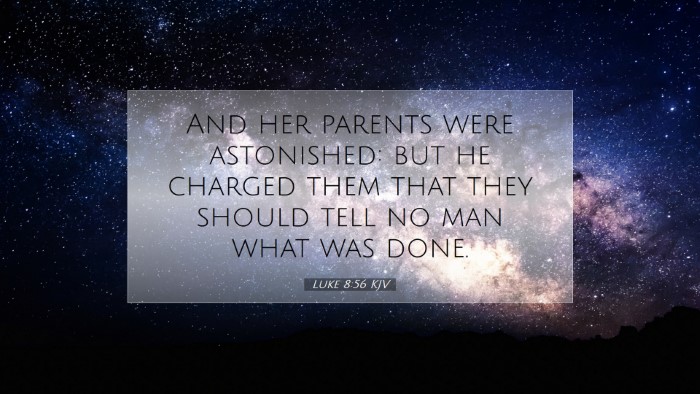Commentary on Luke 8:56
Text: Luke 8:56
“And her parents were astonished: but he charged them that they should tell no man what was done.”
Introduction
This verse concludes the account of Jesus' miraculous healing of a young girl who was believed to be dead. The astonishment of the parents reflects the gravity of the miracle, while Jesus' command for silence signifies a deeper spiritual truth. Here, we delve into the implications of this miracle through a synthesis of insights from esteemed public domain commentaries.
Contextual Analysis
To properly interpret Luke 8:56, it is essential to understand the surrounding narrative. Earlier in the chapter, Jesus is approached by Jairus, a leader of the synagogue, whose daughter is gravely ill. As Jesus makes His way to Jairus’ house, He is interrupted by a woman suffering from a chronic ailment who is healed simply by touching Jesus' garment. Afterward, Jesus arrives at Jairus’ home and raises the girl from the dead.
Parental Astonishment
The reaction of the parents, who were utterly astonished, highlights the miraculous nature of this event. According to Matthew Henry, their astonishment can be interpreted both as a response to the unexpected nature of their daughter’s restoration as well as an awareness of divine intervention. It serves as a reminder of how the miraculous power of Jesus can surpass human understanding.
Furthermore, Albert Barnes emphasizes that their astonishment reflects a mixture of joy and disbelief. In a moment of profound emotional upheaval, witnessing their daughter, who was believed to be lifeless, restored to them would evoke a myriad of feelings. It illustrates the transformative impact of Christ’s miracles on individuals and families.
The Command of Silence
“He charged them that they should tell no man what was done.” The directive provided by Jesus is significant and warrants careful reflection. Adam Clarke posits that this command serves multiple functions. Firstly, it protects Jesus' ministry from premature publicity that could lead to misunderstandings about His mission. Secondly, it may serve to ensure that faith and understanding of Jesus' identity as the Messiah come from personal experience rather than mere hearsay.
Matthew Henry adds that this command for silence may also be meant to direct the disciples and those present towards true faith. The act of keeping the miracle quiet allows faith to develop within the hearts of those who witnessed it, emphasizing an internal response rather than an outward proclamation.
Theological Themes
- Miracles as Signs of Divine Authority: This event showcases Jesus’ authority over life and death, affirming His identity as the Son of God.
- The Relationship of Faith and Miracles: Miracles often follow acts of faith. The girl's resurrection is rooted in Jairus's faith, paralleling the earlier healing of the woman with the issue of blood.
- Response to the Divine: The parents’ astonishment could be seen as a natural human reaction to encountering the extraordinary. It calls believers to acknowledge and respond to the workings of God in their lives.
- The Nature of Christ’s Mission: Jesus’ instruction to keep the miracle silent reflects His desire to reveal Himself gradually and to focus on spiritual rather than sensational recognition.
Pastoral Applications
For pastors and spiritual leaders, Luke 8:56 presents rich teaching moments. They may consider the following:
- Acknowledge the Astonishment: Just as the parents were astonished at the miracle, the church community must recognize and celebrate God’s works among them.
- Faith’s Role in Miracles: Leaders can encourage congregations to foster an active faith that expects and invites miraculous interventions in their lives.
- The Importance of Discretion: In a world obsessed with sensationalism, this narrative provides a template for understanding the significance of personal faith in the face of public spectacle.
Conclusion
Luke 8:56 is a powerful reminder of both the miraculous works of Christ and the importance of faith. The astonishment of the parents reveals the depths of human emotion in response to divine action, while Jesus’ command for silence invites deeper reflection on the nature of faith and the purpose of miracles in the life of believers. This verse encourages ongoing exploration of how we witness, respond to, and understand Jesus' ministry and miraculous works today.


